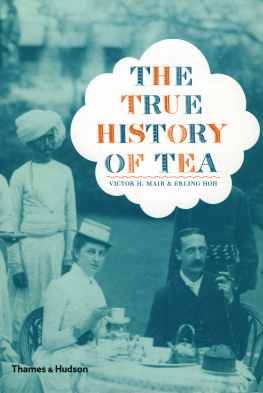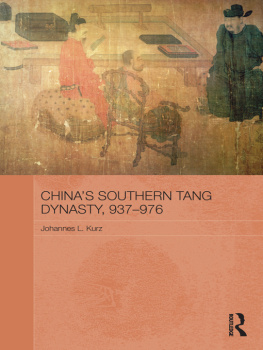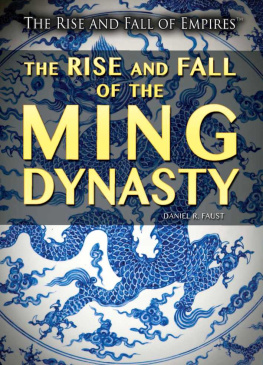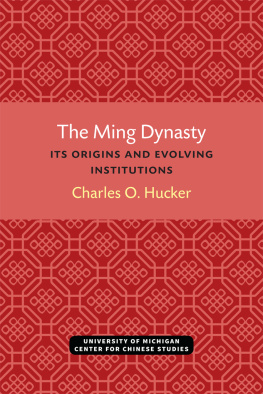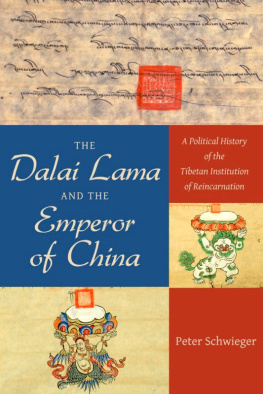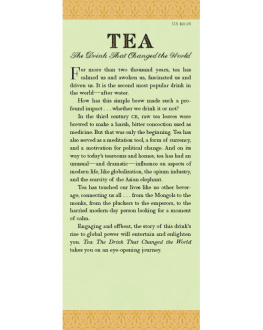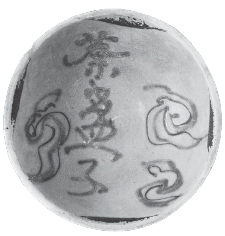
I have tramped all over the hills on the south side of the Yangtze,
And whenever I come to another mountain, I cant help lingering there;
Alone, I carry with me a little moon-like lump from heaven,
Always ready to try the second best spring in the world of men.
The stone path winds back and forth like the spines of nine dragons,
The reflections on the water glimmer like the five lakes of heaven;
Hermit Sun Deng spoke not a word, so I returned, empty-handed,
But halfway down the ridge, I heard the sound of the pines
rustling through the myriad ravines.
On Mount Hui I Visit the Recluse Qin and We Boil
a Lump of Little Dragon Tea, then Climb the Highest Peak
and Gaze at Lake Tai in the Distance
Su Dongpo, 11th century
DEDICATED TO ERLINGS SON NOAH
AND VICTORS SON THOMAS KRISHNA
CONTENTS
A BOTANICAL EXCURSION
THE RIVALS OF TEA
THE HEARTSTRINGS OF NATIONAL PRIDE
SOUTHEAST ASIA AND THE ORIGINS OF TEA
A SLAVE OF YOGHURT
TEA IN THE 1 ST TO 6 TH CENTURIES
GO HAVE SOME TEA!
THE TANG DYNASTY
CLOUDY FEET IN A HARES FUR CUP
THE SONG DYNASTY
BUYING PEACE WITH THE CELESTIAL BEVERAGE
THE TEA AND HORSE TRADE
THE TASTE OF ZEN IS TEA
JAPAN IN THE 12 TH TO 15 TH CENTURIES
SEN RIKY THE TEA MASTER
THE PERFECTION OF THE JAPANESE TEA CEREMONY
HAN XIN COUNTS THE SOLDIERS
TEA IN THE MING AND QING
HOW THE DALAI LAMA GOT HIS NAME
BRICK TEA IN TIBET AND MONGOLIA
WE INVENTED THE SAMOVAR!
THE RUSSIAN CARAVAN TEA TRADE
CONQUERING NEW LANDS
THE ISLAMIC WORLD OF TEA
APPROVED BY PHYSICIANS
THE ADVENT OF TEA IN EUROPE
THE PROGRESS OF THIS FAMOUS PLANT
TEA AND THE OPIUM WARS
A MASTER TEAPOT MAKERS MIDNIGHT RIDE
TEA IN AMERICA
FINEST TIPPY GOLDEN FLOWERY ORANGE PEKOE
INDIA AND CEYLON IN THE 19 TH CENTURY
THE HEYDAY OF THE CLIPPER SHIPS
BRITISH TEA
VIGNETTES FROM THE GLOBAL VILLAGE
TEA IN OUR TIME
APPENDIX A
THE AUTOBIOGRAPHY OF INSTRUCTOR LU
APPENDIX B
A DEBATE BETWEEN TEA AND BEER
APPENDIX C
A GENEALOGY OF WORDS FOR TEA
PROLOGUE
TEA: LEAF OF AWARENESS
wrote the Boston merchant John Adams, who was destined to become the second president of the new republic.
The tea that filled Boston Harbor on that historic night had been picked at dawn in the hinterlands of the Fujian province of China, withered, tossed, oxidized, fired, rolled, packed in wooden chests lined with lead, carried by coolies shod in grass-sandals, tasted and haggled over by plump merchants, journeyed four months in the damp storage of an East Indiaman round the Cape of Good Hope to London, broken, warehoused, and then reloaded by stevedores for the final, fateful voyage across the Atlantic. From its humble origins in the Himalayan foothills of Southeast Asia, the salubrious tea plant has been traded by humans to every nook and cranny of the globe, and adopted by every people under the sun. Long before igniting the American War of Independence, it abetted the poets of China in their greatest achievements. It has burrowed itself to the core of the Japanese soul, solaced many a weary Tibetan yak herder, fueled the midnight cogitations of Britains great inventors, and offered untold numbers of Russian peasants a path to sobriety. Through the centuries, it has provided a safe, stimulating beverage that played a crucial role in reducing human epidemics and making habitation in crowded, bustling cities possible. In the modern world, it marks the days rhythm for hundreds of millions of people, from the Koryaks of the Kamchatka Peninsula in Russia to the Samburu pastoralists of northern Kenya.
It is precisely the epic nature of teas odyssey that has always made its history so difficult to write. With its botanical, medical, religious, cultural, economic, anthropological, social, and political dimensions, with its roots in antiquity and utter unconcern for distances and linguistic divides, the task of gathering its many strands into a single story for the general reader has always proved daunting for authors, whether from the West or the East. Yet in the storerooms of the worlds libraries, and in the archives of the Internet, lie reams of books and journals that contain the meticulous, passionate labors of poets, historians, scientists, and humanists, each shedding light on a particular aspect of tea history. In The True History of Tea , we have endeavored to consult these documents and original sources (in a number of occidental and oriental languages), to distinguish fact from popular lore, to clear up many misunderstandings regarding this beloved beverage, and to distil our research into a tale that can be enjoyed by anybody with an interest in tea and its remarkable place in the history of humankind.
The first chapter surveys an array of the plants apart from tea that humans have experimented with in search of a morning perk, relief from hunger and fatigue, religious experience, and artistic inspiration. In follows the diffusion of tea eastward along the Yangtze river, its adoption by Buddhists, Taoists, and herbal doctors, and its first recorded use as an alternative to alcohol and agent of temperance. In northern China, however, tea was initially rejected by the nomadic Tabgatch rulers, who considered their own fermented horse milk a vastly preferable beverage.
) evolved as a cornerstone of Chinas foreign policy.
From China, tea was dispersed around the world along three main paths: firstly, eastward to Japan; secondly, westward by land, initially to Tibet, Mongolia, Central Asia and Iran, and later to Russia and its Slavic neighbors; and thirdly, by the British (and other European nations) around the world by sea: to Western Europe, North and South America, Indonesia, India, Ceylon (Sri Lanka), Australia, New Zealand, the Fiji Islands, Morocco, and East Africa. With the arrival of tea in Japan (
In the Ming dynasty (). This inevitably brought them into contact with the Chinese empire, and after a few initial skirmishes, the two countries settled down to a relatively peaceful and prosperous trading relationship. Caravans of camels and ox-carts laden with tea traversed the Gobi Desert to the Mongol border south of Lake Baikal, where the market town of Kyakhta, founded in 1727, grew into one of the wealthiest cities in the Russian empire.

Tea consumption around the globe in liters per person per year (199496).

The heartland of tea lay in Southeast Asia, northeastern India, and southwest China.
Along the ancient Silk Road that skirted the fringes of the vast Taklamakan desert and continued over the Pamir mountains into the fertile Ferghana valley, tea gradually supplanted silk as the staple commodity, and from the bazaars of Samarqand and Bukhara, the new beverage spread to Persia and Afghanistan (). The famous Swedish botanist Carl Linnaeus made an attempt to cultivate the tea plant, but was thwarted by the harsh Nordic winter. As Britain turned to opium from India as a replacement for silver to pay for its tea, tensions with China escalated, and in 1840, the first cannon balls of the Opium Wars were fired.
Contrary to popular perception, it was not the villainous role of tea in Americas road to independence that turned the young republic into a nation of coffee-drinkers, and tea remained a popular beverage in America throughout the 19th century (). Loading the new seasons tea in May off Fuzhous Pagoda Anchorage, the tea clippers, gleaming with polished brass and teakwood, raced each other every year round the Cape of Good Hope, until the Suez Canal, opened in 1869, cut the passage to London short by thousands of miles and ushered in the age of the steamship.
Next page
